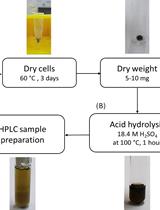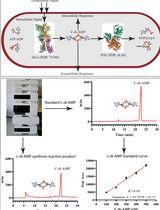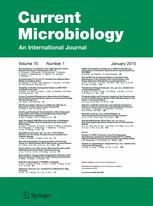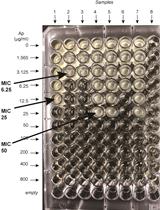- EN - English
- CN - 中文
Extraction and Quantification of GABA and Glutamate from Cyanobacterium Synechocystis sp. PCC 6803
从蓝藻集胞藻属PCC 6803提取和量化GABA和谷氨酸盐
发布: 2016年09月20日第6卷第18期 DOI: 10.21769/BioProtoc.1928 浏览次数: 12256
评审: Maria SinetovaSeda EkiciVinai Chittezham Thomas

相关实验方案

酸水解-高效液相色谱法测定集胞藻PCC 6803中聚3-羟基丁酸酯的含量
Janine Kaewbai-ngam [...] Tanakarn Monshupanee
2023年08月20日 1641 阅读

基于高效液相色谱法的史氏分枝杆菌DisA环二腺苷酸(C-di-AMP)合成酶活性研究
Avisek Mahapa [...] Dipankar Chatterji
2024年12月20日 1598 阅读
Abstract
GABA (γ-amino butyric acid) is a biologically active four carbon non-protein amino acid found in prokaryotes and eukaryotes. Glutamate is a five carbon α-amino acid which can be converted to GABA catalyzed by the enzyme glutamate decarboxylase. In this protocol, we describe the procedure for extraction and quantification of GABA and glutamate from cells of the cyanobacterium Synechocystis sp. PCC 6803 (hereafter Synechocystis). Apart from Synechocystis, this protocol has already been successfully tested for the cyanobacterium Nostoc punctiforme and for the green alga Tetraspora sp. CU2551. The protocol can also be used for the analyses of other primary amino acids. We have successfully employed this protocol in our studies of GABA and glutamate analyses in Synechocystis (Kanwal and Incharoensakdi, 2016).
Keywords: GABA assay (GABA法)Background
Amino acid analysis has been done previously by employing a number of methods that include the detection using thin layer chromatography or ion exchange separation coupled with post-column derivatization with ninhydrin method or also using HPLC by fluorescent detection. However, several challenges are encountered in those detection methods such as poor sensitivity, degradation of derivatives, formation of multiple derivatives and longer retention times causing higher solvent consumption. Furthermore, the UV detection methods alone could not be used owing to optically inactive nature of amino acids.
Here, we describe the detailed procedure for extraction and analyses of amino acids such as GABA and glutamate in Synechocystis. The method used for amino acids separation and detection is high performance reversed-phase liquid chromatography followed by UV detection of pre-column OPA (o-phthaldehyde) derivatization of amino acids adopted from Henderson et al. (2006). This method offers several advantages over previous methods by improving the sensitivity of detection. Reversed-phase chromatography allows faster separation of amino acids, whereas UV detection offers improved sensitivity. OPA derivatization of amino acids results in stable derivatives that make the UV detection of amino acids possible. The method also offers the detection and quantification of amino acids within 26 min, which consequently reduces solvent consumption.
Materials and Reagents
- 50 ml polypropylene tubes (Corning®, CentristarTM, Mexico)
- 1.5 ml Eppendorf tubes (Hycon plastics, catalog number: HCE-1004-MIC )
- 200 µl conical inserts with polymer feet (Borosilicate glass) (JG Finneran, USA)
- Amber wide-opening vial with screw cap (Borosilicate glass) (JG Finneran, USA)
- 0.2 µm Millipore filter (Nylon or cellulose filter membrane) (Sartorius Stedim biotech, Germany)
- Synechocystis cells (fresh or frozen at -20 °C)
- BG11 growth medium
- Deionized water
- Methanol, AR grade (RCI Labscan, Thailand)
- Ethanol, AR grade (QRec, New Zealand)
- Chloroform (RCI Labscan, Thailand)
- Hydrochloric acid (HCl) (QRec, New Zealand)
- NaH2PO4 (Carlo Erba Reagents, Chaussée du Vexin, Val de Reuil, France)
- NaOH (Merck, Germany)
- UP water, HPLC grade (TEDIA, OH, USA)
- Acetonitrile CAN, HPLC grade (Burdick and Jackson, Korea)
- Methanol (MeOH), HPLC grade (Burdick and Jackson, Korea)
- Standards of glutamate and GABA, > 99% purity (Sigma-Aldrich)
- 0.4 M borate buffer, pH 10.2 (Agilent Technologies, catalog number: 5061-3339 )
- O-phthaldehyde reagent (OPA) (Agilent Technologies, catalog number: 5061-3335 )
- BG11 growth medium (see Recipes)
- HPLC solvent A (see Recipes)
- HPLC solvent B (see Recipes)
- OPA reagent (see Recipes)
Equipment
- Pyrex® 250 ml conical flasks (Corning, Pyrex®, catalog number: 4980 )
- Shaker (Eppendorf, model: InnovaTM 2100 )
- Tabletop centrifuge (Hettich Lab Technology, model: MIKRO220/220R )
- Vortex mixer (Scientific Industries, model: SI-0236 )
- Ultrasonic laboratory homogenizer (Sonuplus UW2200)
- Centrivap concentrator (Labconco, USA)
- Shimadzu prominence ultra-fast liquid chromatography system (Shimadzu Scientific Instruments)
- Shimadzu prominence autosampler (Shimadzu Scientific Instruments, model: SIL-21A HT )
- Degasser (Shimadzu Scientific Instruments, model: DGU-20A5 )
- UV-vis detector (Shimadzu Scientific Instruments, model: SPD-20A )
- Reverse phase column (ZORBAX Eclipse AAA analytical column, 4.6 x 150 mm, 5.0 μm) (Agilent Technologies, catalog number: 93400-902 )
- Guard column (ZORBAX Eclipse AAA analytical guard column, 4.6 x 12.5 mm, 5.0 μm) (Agilent Technologies, catalog number: 820950-931 )
Procedure
文章信息
版权信息
© 2016 The Authors; exclusive licensee Bio-protocol LLC.
如何引用
Kanwal, S. and Incharoensakdi, A. (2016). Extraction and Quantification of GABA and Glutamate from Cyanobacterium Synechocystis sp. PCC 6803. Bio-protocol 6(18): e1928. DOI: 10.21769/BioProtoc.1928.
分类
微生物学 > 微生物生物化学 > 其它化合物
生物化学 > 其它化合物 > 氨基酸
您对这篇实验方法有问题吗?
在此处发布您的问题,我们将邀请本文作者来回答。同时,我们会将您的问题发布到Bio-protocol Exchange,以便寻求社区成员的帮助。
提问指南
+ 问题描述
写下详细的问题描述,包括所有有助于他人回答您问题的信息(例如实验过程、条件和相关图像等)。
Share
Bluesky
X
Copy link











